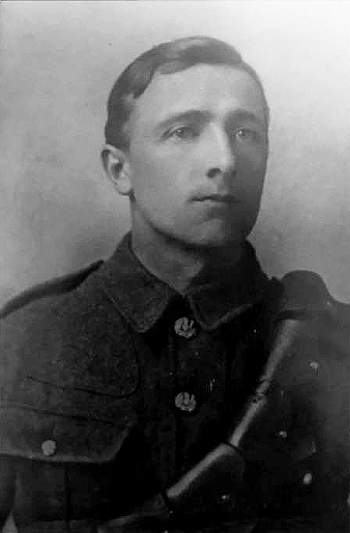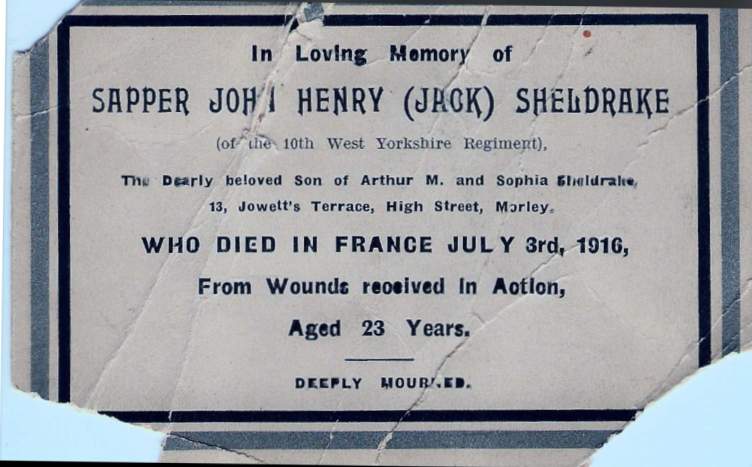 Sapper John Henry (Jack) Sheldrake, 12915, 10th Battalion, West Yorkshire Regiment (Prince of Wales's Own)
Sapper John Henry (Jack) Sheldrake, 12915, 10th Battalion, West Yorkshire Regiment (Prince of Wales's Own)
John Henry Sheldrake was born on the 1st January 1893 in Ossett, the son of rag carbonizer Arthur Martin Sheldrake, born Mendlesham, Suffolk and Sophia (nee Vickers) born Ossett who had married at Christ Church, South Ossett on the 5th February 1887. There were eight children born to the Sheldrakes, seven boys and one girl between 1887 and 1909. John Henry was the third child to be born and by the age of 18 in 1911, he was working in a coal mine as a pony driver.
In 1901 the Sheldrake family were living in Healey, Ossett, but by 1909 they had moved to live at 13, Jowett Terrace, High Street, Morley.
Jack Sheldrake's military record has not survived, but the 10th (Service) Battalion of the West Yorkshire Regiment was raised in York on the 3rd September 1914 as part of Kitchener's Second New Army and joined 50 Brigade, 17th (Northern) Division. After initial training close to home, the Division moved to Dorset to continue training, then in late May 1915, moved to the Winchester area. The Division had been selected for Home Defence duties, but this was reversed and they proceeded to France, landing at Boulogne on the 14th July 1915, concentrating near St. Omer. They moved into the Southern Ypres Salient for trench familiaristaion and then took over the front lines in that area. In the spring of 1916 they were in action at the Bluff, south-east of Ypres on the Comines canal then moved south to the Somme seeing action during the Battle of Albert in which the Division captured Fricourt and the Battle of Delville Wood.
Sapper Jack Sheldrake died from wounds aged 23 years on the 3rd July 1916 after being hit by enemy fire during the opening day of the brutal Battle of the Somme in action to capture the village of Fricourt. The 10th West Yorkshires lost over 400 men killed and over 350 more wounded and their casualties were the highest for a single battalion on the first day of the Battle of the Somme.
1st July 1916: 21st Division - 50 Brigade (attached from 17th Division). The two attacking companies of the 10th West Yorkshires pushed through to Red Cottage on a frontage of about 600 yards, and with little loss. But by the time their 3rd and 4th Companies advanced, the machine guns in the Tambour and Fricourt were in action, virtually annihilating them in their attacking waves, and only a few small groups reached the German front line where they remained until after dark. The troops at Red Cottage were overcome later in the morning, except a few who joined up with the right of the 63 Brigade to their north.2
He is buried at I. B. 23. in Heilly Station Cemetery, Mericourt-L'Abbe, France. Mericourt-l'Abbe is a village approximately 19 kilometres north-east of Amiens and 10 kilometres south-west of Albert. Heilly Station Cemetery is about 2 kilometres south-west of Mericourt-l'Abbe, on the south side of the road to Corbie.
The 36th Casualty Clearing Station was at Heilly from April 1916. It was joined in May by the 38th, and in July by the 2/2nd London, but these hospitals had all moved on by early June 1917. The cemetery was begun in May 1916 and was used by the three medical units until April 1917. From March to May 1918, it was used by Australian units, and in the early autumn for further hospital burials when the 20th Casualty Clearing Station was there briefly in August and September 1918. The last burial was made in May 1919. There are now 2,890 Commonwealth servicemen of the First World War buried or commemorated in this cemetery. Only 12 of the burials are unidentified and special memorials are erected to 21 casualties whose graves in the cemetery could not be exactly located. The cemetery also contains 83 German graves. The burials in this cemetery were carried out under extreme pressure and many of the graves are either too close together to be marked individually, or they contain multiple burials. Some headstones carry as many as three sets of casualty details, and in these cases, regimental badges have had to be omitted. Instead, these badges, 117 in all, have been carved on a cloister wall on the north side of the cemetery.

Sapper John Henry Sheldrake is remembered on the Morley Memorial, Scatcherd Park, his home town at the time of his death. His name was quietly added to the Ossett War Memorial with little or no notice in October 2023.
References:
1. Ancestry Family Trees for John Henry Sheldrake.
2. "The Somme - The Day-By-Day Account" by Chris McCarthy, Brockhampton Press